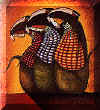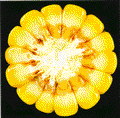
AMERICAN CORN (MAIZE)
American corn or more properly maize is a grass (Podacae) that was domesticated 5,000-7,000 years ago by Native American people in the Tehuacan Valley in the state of Puebla, Mexico. The word corn comes from an English word that means any hard kernel or grain and in some texts does not refer to 'Indian corn' or maize.

Since A.D. 1492 the world has increased its population 4-5 times and doubled between 1650-1850. Many scholars have proposed a variety of causal factors, but the increase and improvement of the food supply is clearly the most important factor in population explosions since the beginning of the Columbian Exchange. It is also clear that the addition of Native American food plants is the most significant change for that world food supply. Some of the most important plants from America are:
| Maize | Potato | Sweet potato |
| Beans | Chenopods | Manioc/Cassava |
| Squash | Peanut | Avocado |
| Chili peppers | Tomato | Pineapple |
| Sunflower | Peanut/Groundnut | Cocoa/Chocolate |
However, in terms of economic and cultural impact maize and potato are the most important and therefore made the list in the Columbian Exchange. There are over forty plants that diffuse to various parts of the world that originated from America and were first cultivated or domesticated by Native American people.
Maize (American Corn) is most significant in terms of agronomy and world wide economic
impact. Maize produces good crops in various climatic zones and it prospers in areas too
dry for rice and too wet for wheat; thus fitting into a niche between the two. Maize grows
quickly and produces almost double the yield of wheat.
Maize produces good crops in various climatic zones and it prospers in areas too
dry for rice and too wet for wheat; thus fitting into a niche between the two. Maize grows
quickly and produces almost double the yield of wheat.
| MAIZE: 7.3 million calories/hectare |
| WHEAT : 4.2 million calories/hectare |
Maize is used as human food, livestock feed, and export. Maize has gone through complex changes in use and form in parts of Southwestern Europe first and later in Southeastern Europe in the last 100 years. In parts of Africa, India, and China maize continues to fit between various ecological niches. It was combinations of plants from around the world that bolstered economies and resulted in exponential population growth. In Europe maize is combined with wheat, barley, cabbage, beets, and the potato. In Africa maize is combined with millet, sorghum, yams and sweet potato. Finally, in Asia maize is combined with rice or millet, taro, sweet potato, and wheat. It is these diverse combinations that made maize so important to the rest of the world as it augmented other crops as a food and livestock feed. Maize continues to be important in America and in some areas is a primary food.
The use of maize tends to depend on which variety of plants, ears, and kernel
that are combined with endless color variations of kernels to include yellow, white, red,
blue, black, grey, and speckled. The varieties are classified into five basic categories:
VARIETY |
CHARACTERISTIC |
USE |
Flint |
Large ears/kernel | Ripe, gruel, meal, hominy |
Dent |
Med. ears, dense kernel | Ripe, meal, feed |
Sweet |
Long ears, sm. rd. kernel | Green, steamed, stew, relishes |
Pop |
Sm. ears, sm. kernel | Ripe, popped |
Pod |
Short ears, kernel w/ind. husk | Green/Ripe, meal, roasted |
Many areas in America use the flint and dent corns in their ripe form, which is where the ear husk has turned brown and the kernel hard. Rather than grinding the dry hard kernel, the kernals are put in a water solution mixed with wood ash (culinary ash) and boiled. This produces a product called hominy or, in Mexico, pazole. This makes the corn far more nutritious with more minerals. Many stews or soups use the hominy or pazole. In Mexican cusine the pazole is used in menudo (pancita).These may also be processed into various products such as grits or masa; which ultimately end up in gruel or as a meal for such products like corn tortillas and various cornbreads.. Many cornbreads such as corn dodgers, corn pone or hushpuppies are baked or deep fried cornbreads. If your from Northern areas of the U.S. you are more familiar with sweet corn on the cob or off the cob as a vegetable. Finally, popcorn was originally produced by Native Americans (3,000 years ago+) by placing the dry kernals or cobs on a hot rock slab. This has become a mainstay in our movie theaters and in American homes. In some places they coat the popcorn in various kinds of sugar. However, in some parts of the world popcorn is an oddity and corn is ground up as animal feed.

Copyright � S.J. Crouthamel